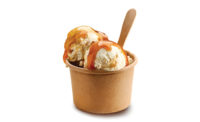The cultured dairy segment has been tossing multiple balls in the air in an effort to meet numerous — and sometimes seemingly conflicting — consumers trends. This balancing act has been delivering mixed results for the categories within the segment.
According to data from Chicago-based market research firm IRI, dollar sales within the yogurt category — the largest cultured dairy category, by far — increased 2.5% to $7,343.1 million during the 52 weeks ending Sept. 6, 2020. However, unit sales fell 3.2% to 4,002.0 million during the same timeframe.
Milk | Cheese | Cultured | Ice Cream | Butter | Non-dairy Beverages | Ingredients | Exports
The cottage cheese category performed similarly. Although dollar sales increased 3.4% to $1,080.7 million, unit sales took a 0.4% dive to 426.5 million.
However, the other cultured dairy categories fared much better. Dollar sales within the sour cream category shot up 11.8% to $1,398.7 million; unit sales rose 8.8% to 681.4 million. In addition, the cream cheese category saw a 14.9% jump in dollar sales (to $2,021.0 million) and a 9.5% increase in unit sales (to 741.5 million).
The good news for the latter categories could be attributed, at least in part, to consumers preparing more food at home during the coronavirus pandemic.
“Without commutes, morning routines slow down, and more consumers are able to take a few minutes to enjoy a bagel and cream cheese,” says Erica Watkins, brand manager for the Philadelphia cream cheese brand of Pittsburgh- and Chicago-based Kraft Heinz Co. “Cheesecake is a delicious dessert that is simple to make, and many consumers have turned to it and baking, more generally, as an outlet to decompress. In fact, cheesecake was a top 10 most-Googled recipe in April.”
And on the sour cream side, Tirso Iglesias, senior vice president of sales and marketing for Cacique Inc., Monrovia, Calif., notes that his company saw huge increases from retail customers in March.
No hold time
The yogurt category, in particular, has found itself with an abundance of props to maneuver. One of those is the trend toward both better-for-you products and products with added health benefits.
“This is not a new thing but it has been sped up with COVID,” says Niel Sandfort, chief innovation officer for Norwich, N.Y.-based Chobani LLC. “Sixty-five percent of consumers are seeking functional benefits from their food and drinks.”
High-protein formulations certainly are part of that push.
Chobani responded to this trend by launching its Chobani Complete platform this summer, he points out. The brand covers a line of high-protein, easy-to-digest lactose-free yogurt products that contains no added sugar. The products come in three different formats: 5.3-ounce cups in Blueberry, Key Lime, Vanilla, Strawberry, Mixed Berry and Peach flavors; 10-ounce shakes in Banana Cream, Mixed Berry Vanilla, Strawberry Cream and Vanilla flavors; and 24-ounce tubs featuring Vanilla flavor.
Minneapolis-headquartered General Mills Inc. also aimed for high protein and low sugar with the introduction of its new :ratio keto-friendly dairy snacks. Made with carefully selected ingredients, the yogurt snacks contain 2 grams of net carbs and 1 gram of sugar per 5.3-ounce serving. They come in five “fruit-forward” flavors: Strawberry, Coconut, Vanilla, Mango and Black Cherry.
“In 2019, ‘keto’ was a popular search term, and 10% of Americans will try [the ketogenic diet] in the next six months,” explains Tsubasa Tanaka, director of marketing in General Mills Dairy Operating Unit, citing data from the NPD Group/Health Aspirations & Behavioral Tracking Service. “There is a demand for low-carb, keto-friendly products.”
For its part, Danimals, a brand of White Plains, N.Y.- and Broomfield, Colo.-based Danone North America, recently launched Super Danimals yogurt. The low-fat yogurt contains probiotics and vitamins C and D to help support children’s immune systems, the brand says. Packaged in 4-ounce cartons retailing in a six-pack format, the yogurt comes in Cherry Vanilla, Blueberry and Strawberry flavors.
But it was in late 2018 that Danone North America disrupted the better-for-you side of yogurt with the introduction of its low-sugar Two Good product line, which is made via a novel slow-straining process.
“The brand was developed to reduce the sugar level to a record-breaking 2 grams and only 80 calories,” says Pedro Silveira, president of U.S. Yogurt for Danone North America, “while still delivering 12 grams of protein per 5.3 ounces without compromising its taste.”
Since that debut, other brands have been innovating in the name of less sugar — another key trend.
Siggi’s, New York, rolled out its first-ever kids’ yogurt pouches in January. The company says the products, sold in packs containing four 3.5-ounce pouches, contain 50% less sugar and 30% fewer ingredients than leading kids’ yogurts. The 2% milkfat yogurts come in kid-friendly flavors that include Strawberry & Banana and Blueberry.
On the drinkable side, Irvine, Calif.-based Good Culture launched organic probiotic smoothies containing no added sugar. Made from yogurt’s kefir cousin, the smoothies feature 12 strains of live and active cultures, including the probiotic powerhouse BB-12. The company says the smoothies are sold in 7-ounce bottles and come in three flavors: Pineapple, Vanilla and Wildberry.
And outside the yogurt category, Good Culture also cut the sugar with the recent introduction of its Good Culture 3G Sugar single-serve, fruit-on-the-bottom cottage cheese.
“Each cup contains only 3 grams of total sugar, all coming from naturally occurring milk sugar, and zero added sugar,” explains Jesse Merrill, cofounder and CEO of the company. “Our 3G line is naturally sweetened with stevia and is loaded with 15 grams of protein. The new range is Keto Certified and supports the growing shift to lower-sugar, higher-protein products.”
Another ball to toss
Another trend some yogurt and other cultured product brands are embracing is that toward full-fat formulation.
“Full fat is definitely on the increase, particularly as it relates to keto-type nutrition plans,” says Emily Bialkowski, sales and marketing manager for Westby Cooperative Creamery, Westby, Wis.
Carl Gerlach, CEO of Kinderhook, N.Y.-based Maple Hill Creamery, agrees that high-fat formulations are of high interest.
“Consumers are utilizing full-fat yogurts for everyday family use,” he says.
This year, Nancy’s Probiotic Foods, Eugene, Ore., launched a line of single-serve organic whole-milk yogurt under the Nancy’s brand. Non-GMO Project Verified and made without pectin or gelatin, the products also boast more than 30 billion live probiotics per serving. They come in four flavors: Plain, Strawberry Vanilla, Mixed Berry and Peach.
And General Mills recently added two limited-edition flavors to its Oui by Yoplait whole-milk-based brand of French-style yogurt. The fall seasonal offerings include a brand-new Apple Pie variety and Pumpkin Caramel, which returned to shelves for the second year.
Outside of the yogurt arena, David’s Deli Triple Cream cream cheese spread — new from Minneapolis-based Crystal Farms — boasts more butterfat than standard cream cheese, says Katie Egan, director of marketing, R&D and category for the company. The product comes in six flavors: Plain, Strawberries & Cream, Onion & Chive, Olive & Rosemary, Everything and Blueberry Lemon Zest.
“[It] provides extra richness and flavor with simple ingredients and nothing artificial,” she adds. “We feel that this innovation addresses three specific areas of demand for more flavor quality, simpler ingredients and packaging that locks in freshness.”
Those “simpler ingredients” are a plus — whether it’s a full-fat or a low-sugar cultured dairy product (or both), consumers are demanding clean labels, Gerlach stresses.
“They want yogurts with as few ingredients as possible,” he says. “They want to see more natural substitutes used in the lower-sugar offerings.”
Bialkowski agrees.
“Clean-label products — and the desire for them by consumers — continues to be the driving force in cultured dairy innovation,” she says. “Over half of what Westby Cooperative Creamery makes now is without stabilizers. Simple, clean dairy is the direction the category is going.”
Bialkowski also notes that clients are asking for yogurts with more probiotics in the name of immune and gut health.
“This desire for healthful foods marries nicely with the clean-label movement as well,” she maintains.
Catching flavor trends
Cultured dairy producers also are trying to match product innovation to current flavor trends.
Addressing the savory trend, Belle Chevre, Elkmont, Ala., added Garden Veggie and Roasted Red Pepper flavors to its lineup of goat’s milk-based chevre cream cheeses in late 2019. The company said the products have less fat and less cholesterol than regular cream cheese — and more than twice the protein.
Tillamook, Ore.-based Tillamook County Creamery Association also went the savory route with a couple of its new Tillamook cream cheese spreads. The line of 7-ounce tubs includes the “world’s first” Aged Cheddar cream cheese, as well as a Very Veggie option. One sweet variety — Seriously Strawberry — and a Plain version round out the mix, which is made without gums, fillers, stabilizers and preservatives.
Consumers are looking for authentic flavors, too, in a convenient product format, says Iglesias.
“This was the inspiration behind the Cacique flavored sour cream product line we introduced in 2017 — Mexican-style sour creams that are infused with authentic flavors and available in a convenient squeezable bottle,” he points out.
In 2021, he adds, Cacique plans to add two new flavors to the existing lineup, which currently includes Spicy Jalapeño, Chipotle and Cilantro Lime.
And General Mills aimed to appeal to children’s palates with the summer launch of its Go-Gurt Slushie lineup. The yogurt-style products come in kid-pleasing Fizzy Blue Raspberry and Fizzy Cherry flavors, says Tanaka, and also boast an innovative fizzing texture.
“Made with low-fat milk, each Fizzy flavor delivers vitamin A, vitamin D and calcium in every serving,” Tanaka adds.
Icelandic Provisions, New York, also combined on-trend flavors with a little something extra in its new Icelandic Provisions Fruit & Nuts skyr lineup. Varieties of the single-serve offerings include Peach Apricot with Almonds, Coconut with Almonds and Apple Cinnamon with Almonds.
“I sincerely think our new Fruit & Nuts line that recently launched is a breakthrough in terms of an eating experience in the yogurt category,” says John Heath, chief innovation officer of Icelandic Provisions. “It’s an innovative approach to the traditional mix-ins varieties of yogurt in that the nuts/seeds are preblended in, yet there’s a strong textural experience for the consumer.”
Limited-edition seasonal flavors are helping cultured dairy processors meet consumer demands for variety, too.
For its part, Danone North America recently debuted two fall-inspired Greek yogurt flavors under its Light & Fit brand: Pumpkin Pie and Toasted Marshmallow. The nonfat yogurts have 12 grams of protein and 80 calories per 5.3-ounce cup and retail in four-packs containing two of each flavor.
And Tillamook took flavor variety to a new level with the recent addition of a line of premium specialty yogurts called the Tillamook Creamery Collection. The creamy low-fat yogurts come in six unique flavor combinations, boast only 9-10 grams of sugar per serving, and contain no artificial sweeteners, flavors or preservatives.
“We created Tillamook Creamery Collection to allow yogurt lovers to create their perfect bite,” says Lara Gish, senior category manager of cultured products at Tillamook. “Each cup includes two side-by-side flavors that can be enjoyed one by one or swirled together ... Every spoonful is crafted the Tillamook way — with quality ingredients and no shortcuts.”
Consumers also are gravitating toward the familiar and nostalgic, Sandfort notes.
“This is where flavors in our [Chobani] Flip range really thrive, like Strawberry Cheesecake, Cookie Dough and Cookies & Cream,” he says. These are the flavor profiles we were raised on, and what we do is flip it upside down and deconstruct these profiles. You get that Cookies & Cream flavor you know and love, but it just happens to be completely natural and super nutrient-dense.”
Despite all of the flavor innovation, Sandfort admits that the classic profiles such as strawberry, blueberry, peach and vanilla continue to show the highest velocity.
Balancing larger sizes
Yet another trend within the cultured dairy segment — specific to the yogurt category — is that toward multi-serve sizes and multi-packs, says Sandfort (which might explain the decline in unit sales the IRI data show).
“We’ve observed that people are spending significantly less time at shelf and, at the same time, shopping less frequently and making bigger trips to grocery stores,” he says. “With this is mind, people are opting for the value and efficiency of multi-serve and multi-pack [options] more than ever before. We see this as a pretty sticky behavior, too.”
The bulk formats provide more value to the consumer, Sandfort adds, and promote greater usage of yogurt as an ingredient.
“This is a great development as the United States consumer starts to use yogurt increasingly like European households,” he maintains.
Gerlach agrees with the trend toward larger yogurt packages, particularly 32-ounce tubs.
“The shift towards large format offers a sustainable option by requiring less packaging and providing more product on hand for recipes and everyday consumption,” he says.
Outside the yogurt arena, large formats aren’t the only packaging that’s trending. For example, pouches are gaining traction for sour cream.
“With a desire to be good stewards of the earth and in response to consumer demand for convenience, [our] creamery will begin manufacturing sour cream in pouches in quarter two 2021,” Bialkowski notes.
Don’t drop the balls
Innovation across the cultured dairy segment will be important for building on the gains made in 2020. Nevertheless, processors seem up to the task.
“As we look to 2021, we see a number of exciting product development opportunities,” says Silveira. “Consumers will remain hungry for yogurt options in new flavors, forms and even new occasions.”
The dramatic shifts in consumer behavior actually have resulted in exciting times for innovators, Heath notes.
“Thinking about how consumers’ emotional needs and physical needs have changed opens up new ideas for product development, and I think you’re going to see some interesting ways the more innovative companies will solve for this.”
In addition to finding ways to innovate, processors will have to overcome some challenges. In the cottage cheese segment, for example, per-capita consumption has declined significantly since the 1970s, Merrill notes.
“We are working to reverse that trend by making relevant products that tick the boxes in terms of what today’s consumer is looking for, including responsible sourcing, cleaner ingredients and craveable taste/texture profiles,” he says.
Processors also will have to find additional ways to address the overarching trend of health and wellness.
“Across the grocery store, there’s been a greater emphasis on food as medicine, and we expect that trend to continue in 2021 and beyond,” Sandfort emphasizes. “With every trip to the store, consumers are looking to do more than just fill their bellies — they want to restore their bodies and replenish their energy.”
Milk | Cheese | Cultured | Ice Cream | Butter | Non-dairy Beverages | Ingredients | Exports











